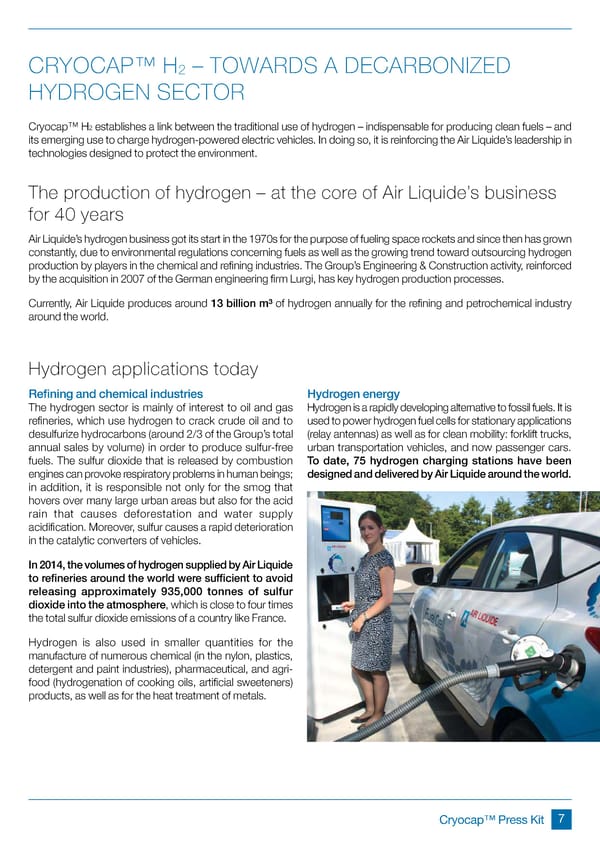CRYOCAP™ H – TOWARDS A DECARBONIZED 2 HYDROGEN SECTOR 2 Cryocap™ H establishes a link between the traditional use of hydrogen – indispensable for producing clean fuels – and its emerging use to charge hydrogen-powered electric vehicles. In doing so, it is reinforcing the Air Liquide’s leadership in technologies designed to protect the environment. The production of hydrogen – at the core of Air Liquide’s business for 40 years Air Liquide’s hydrogen business got its start in the 1970s for the purpose of fueling space rockets and since then has grown constantly, due to environmental regulations concerning fuels as well as the growing trend toward outsourcing hydrogen production by players in the chemical and refining industries. The Group’s Engineering & Construction activity, reinforced by the acquisition in 2007 of the German engineering firm Lurgi, has key hydrogen production processes. Currently, Air Liquide produces around 13 billion m³ of hydrogen annually for the refining and petrochemical industry around the world. Hydrogen applications today Refining and chemical industries Hydrogen energy The hydrogen sector is mainly of interest to oil and gas Hydrogen is a rapidly developing alternative to fossil fuels. It is refineries, which use hydrogen to crack crude oil and to used to power hydrogen fuel cells for stationary applications desulfurize hydrocarbons (around 2/3 of the Group’s total (relay antennas) as well as for clean mobility: forklift trucks, annual sales by volume) in order to produce sulfur-free urban transportation vehicles, and now passenger cars. fuels. The sulfur dioxide that is released by combustion To date, 75 hydrogen charging stations have been engines can provoke respiratory problems in human beings; designed and delivered by Air Liquide around the world. in addition, it is responsible not only for the smog that hovers over many large urban areas but also for the acid rain that causes deforestation and water supply acidification. Moreover, sulfur causes a rapid deterioration in the catalytic converters of vehicles. In 2014, the volumes of hydrogen supplied by Air Liquide to refineries around the world were sufficient to avoid releasing approximately 935,000 tonnes of sulfur dioxide into the atmosphere, which is close to four times the total sulfur dioxide emissions of a country like France. Hydrogen is also used in smaller quantities for the manufacture of numerous chemical (in the nylon, plastics, detergent and paint industries), pharmaceutical, and agri- food (hydrogenation of cooking oils, artificial sweeteners) products, as well as for the heat treatment of metals. Cryocap™ Press Kit 7
 Cryocap Page 6 Page 8
Cryocap Page 6 Page 8